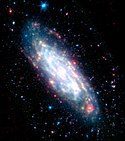NGC 3198
| Galaxie NGC 3198 | |
|---|---|
 | |
| Aufgenommen mithilfe des Nicholas U. Mayall Telescope | |
| AladinLite | |
| Sternbild | Großer Bär |
| Position Äquinoktium: J2000.0, Epoche: J2000.0 | |
| Rektaszension | 10h 19m 54,9s[1] |
| Deklination | +45° 32′ 59″[1] |
| Erscheinungsbild | |
| Morphologischer Typ | SB(rs)c / HII[1][2] |
| Helligkeit (visuell) | 10,2 mag[2] |
| Helligkeit (B-Band) | 10,9 mag[2] |
| Winkelausdehnung | 8,5′ × 3,3′[2] |
| Positionswinkel | 35°[2] |
| Flächenhelligkeit | 13,7 mag/arcmin²[2] |
| Physikalische Daten | |
| Rotverschiebung | 0,002202 ± 0,000001[1] |
| Radialgeschwindigkeit | (660 ± 1) km/s[1] |
| Hubbledistanz vrad / H0 | (30 ± 2) · 106 Lj (9,33 ± 0,65) Mpc [1] |
| Geschichte | |
| Entdeckung | Wilhelm Herschel |
| Entdeckungsdatum | 15. Januar 1788 |
| Katalogbezeichnungen | |
| NGC 3198 • UGC 5572 • PGC 30197 • CGCG 240-030 • MCG +08-19-020 • 2MASX J10195499+4532588 • GC 2066 • H I 199 • h 695 • | |
NGC 3198 ist eine Balken-Spiralgalaxie vom Hubble-Typ SBc im Sternbild Großer Bär am Nordsternhimmel, die schätzungsweise 30 Millionen Lichtjahre von der Milchstraße entfernt ist.
Das Objekt wurde am 15. Januar 1788 von dem deutsch-britischen Astronomen Wilhelm Herschel entdeckt.[3]
Mithilfe von Weltraumteleskopen wurde sie in auf der Erde nicht sichtbaren Spektralbereichen aufgenommen.
Ultraviolettaufnahme der Galaxie NGC 3198 mittels GALEX.
Aufnahme im sichtbaren Spektrum und nahem Infrarot, SDSS.
Die Galaxie NGC 3198 aufgenommen im Infrarotem vom Spitzer-Weltraumteleskop.
Weblinks
- Spektrum.de: Amateuraufnahmen [1][2]
- SIMBAD Astronomical Database
Einzelnachweise
Auf dieser Seite verwendete Medien
NGC 3198
Autor/Urheber: Sloan Digital Sky Survey, Lizenz: CC BY 4.0
The sky image is obtained by Sloan Digital Sky Survey, DR14 with SciServer.
Angle of view: 9' × 9' (0.3" per pixel), north is up.
Details on the image processing pipeline: https://www.sdss.org/dr14/imaging/jpg-images-on-skyserver/NGC 3198 by GALEX
Autor/Urheber: unknown, Lizenz: CC BY 4.0
A Lonely Spiral in a Tapestry of Galaxies
This stunning image features NGC 3198, a galaxy that lies about 47 million light-years away in the constellation Ursa Major. This image was taken with the Mosaic instrument on the 4-meter Nicholas U. Mayall Telescope at Kitt Peak National Observatory, a Program of NSF’s NOIRLab, and shows the full extent of the galaxy, from the bright central bulge to the tenuous outer reaches of the tightly-wound spiral arms. Almost all the objects lurking in the background are galaxies or galaxy clusters — a sea of distant galaxies of all shapes, sizes, and orientations.
Accurately measuring the distance to an astronomical object — everything from our own Sun to galaxies such as NGC 3198 — is an age-old challenge for astronomers, and requires a combination of measurements and methods. The galaxy at the heart of this image has played a part in this astronomical undertaking by allowing astronomers to calibrate astronomical distance measurements based on a type of variable star known as a Cepheid variable.
Credit:
KPNO/NOIRLab/NSF/AURA.
Acknowledgments: PI: M T. Patterson (New Mexico State University)
Image processing: Travis Rector (University of Alaska Anchorage), Mahdi Zamani & Davide de Martin






